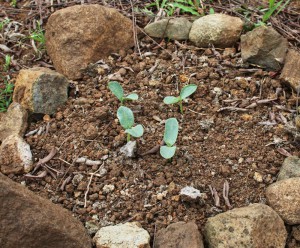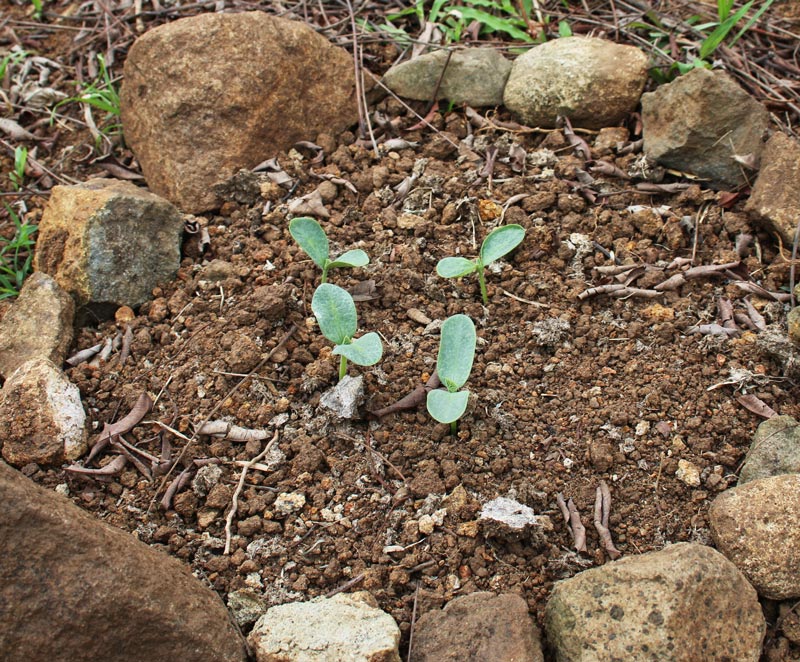
I recently sold an article to Self-Reliance Magazine and I see they’ve now shared it on their website:
Melon Pits, Sheet Composting and Compost Tea
As an utter cheapskate, I’ve spent much of my life finding ways to re-use and stretch everything I own. This definitely extends into the gardening realm.
If you’re like me, you can’t stand throwing away anything that might feed the soil. If you’ve been known to snag bags of leaves from beside the road, or take home coffee grounds from the office for your roses, keep reading, because I’ve got some ideas for you on composting almost everything without building a pile, buying a tumbler, tending worms, or measuring temperatures.
Composting doesn’t have to be a big deal. In its basic form, it’s just a process of rot nature has been performing for millennia without any help from gardeners with pitchforks and thermometers. Sure, you can build a compost pile, balance ratios, and work to get those handfuls of black gold, but if you don’t feel like all that hard work, take a page from my book and pop stuff back into the ground in one of these ridiculously easy ways.
Melon pits
One of my favorite methods for composting was inspired by Steve Solomon’s book, Gardening When It Counts. In it he describes how Native Americans used to bury their refuse and plant on top.
I’ve done the same on my homestead with melons and had great results, hence the nickname “melon pits.” We’ve planted squash, sunflowers, okra, and even trees in our melon pits and all have done well.
To create a melon pit, just dig a 2-3 foot deep hole and dump in rich material such as fresh manure, kitchen scraps, slaughter wastes, ashes, and more. I also bury chunks of wood that will rot into moisture reservoirs. Cover up the pit and water well to make sure the air pockets are filled, then plant with the crop of your choosing. Squash and melons make great choices because they’re normally planted on mounds and set free to wander. I’ve punched a hole in my grass, filled it with everything from old beef stew to chicken manure, then planted it with watermelons and had them spread luxuriously across my weedy lawn and bear without any supplemental fertilizer and very little water.
This is a dead-simple pile-free way to get rid of items that would be hard to compost conventionally or would be too hot for direct application to the garden. Just make sure you bury items like meat well so they aren’t discovered by animals. There’s nothing sadder than finding your vines pulled up by inquisitive possums.
Sheet composting
Sheet composting is another way to directly add compost to the soil. It has regained popularity lately due to the permaculture crowd and folks like Paul Gautschi, of Back to Eden fame, and Patricia Lanza, author of Lasagna Gardening. Both of their methods, in turn, are pre-dated by Ruth Stout’s “deep mulch” method of throwing around lots and lots of straw as mulch.
Beyond typical mulches like wood chips and straw, however, it’s easy to incorporate a lot of “waste” materials from around the house.
I prefer soil to mulch in my annual gardens due to the sheer size of the space I garden. However, I am a big believer in mulching around the fruit trees and shrubs in my food forest. To add fresh materials to a mulched area is easy: just rake back a patch, dump in the new stuff, then recover with mulch…


2 comments
What about pests in your pumpkins? Tonight I found green inch worms all over my pumpkin leaves! They are only a few weeks old! I leave on vacation in the morning. I have someone to water the garden, but I don’t expect them to weed too. Help!
I would hand-pick them off for now, and maybe spray with neem oil.
Comments are closed.